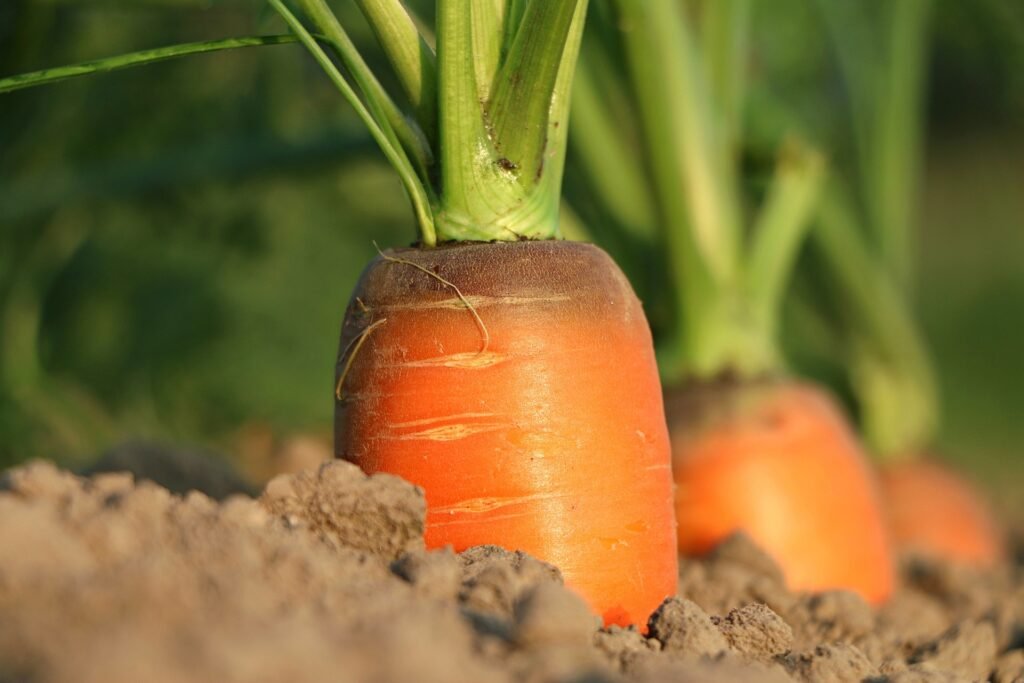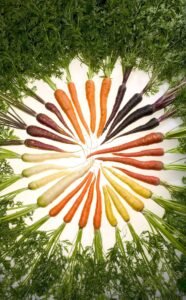
Carrots are above all one of the most popular vegetables in the world. They are crunchy, sweet, and good for your health. They are also easy to grow in your garden, as long as you follow some simple steps. In this article, you will learn everything you need to know about growing carrots, from choosing the right seeds to harvesting and storing them.
Choosing the Right Seeds
There are many different types of carrots, with different shapes, colors, and flavors. Some are long and orange, some are short and round, and some are purple or yellow. However, you can choose the ones that you like best, or try something new. Some of the most common varieties are:
- Nantes: These are the classic carrots that you see in the grocery store. They are sweet, crisp, and cylindrical, with blunt tips. They grow well in most soils and climates.
- Danvers: These are similar to Nantes, but they have tapered tips and are more tolerant of heavy or rocky soil. They are good for making carrot juice or soup.
- Chantenay: These are shorter and wider than Nantes, with broad shoulders and conical shape. They are good for growing in containers or raised beds, as they don’t need much space. They are also very sweet and tender.
- Imperator: These are the longest and thinnest carrots, with pointed tips and smooth skin. They need deep, loose, and sandy soil to grow well. They are very flavorful and crunchy.
- Parisian: These are the smallest and cutest carrots, with a round shape and bright orange color. They are perfect for snacking or salads, as they are very tender and sweet. They also grow fast and can be harvested early.

You can buy carrot seeds online or at your local garden center. Make sure to check the expiration date and the germination rate of the seeds. You want fresh and viable seeds that will sprout quickly and grow healthy.
Preparing the Soil
Carrots need well-drained, loose, and fertile soil to grow well. They don’t like hard, compacted, or clay soil, as it will make them grow crooked or forked. They also don’t like too much nitrogen, as it will make them grow more leaves than roots. You can prepare the soil by:
- Tilling or digging the soil to a depth of 10 to 12 inches, removing any rocks, stones, or clumps.
- Adding some organic matter, such as compost, manure, or peat moss, to improve the soil texture and fertility.
- Adding some sand or perlite, if the soil is too heavy or sticky, to improve the drainage and aeration.
- Testing the soil pH, and adjusting it if needed. Carrots prefer slightly acidic soil, with a pH of 6.0 to 6.8. You can use lime to raise the pH, or sulfur to lower it.
- Raking the soil surface to make it smooth and level.
Planting the Seeds
Carrots are a cool-season crop, which means they grow best in Spring or Fall when the temperatures are mild and the days are short. You can plant the seeds about 2 to 3 weeks before the last frost date in spring, or 10 weeks before the first frost date in fall. To plant the seeds, you need to:
- Make shallow furrows, about 1/4 to 1/2 inch deep, in the soil, spacing them 12 to 18 inches apart.
- Sprinkle the seeds thinly along the furrows, spacing them 1 to 2 inches apart. You can mix the seeds with some sand or radish seeds, to make them easier to sow and to mark the rows.
- Cover the seeds lightly with soil, and gently press the soil down.
- Water the soil well, but gently, to avoid washing away the seeds.
- Keep the soil moist, but not soggy, until the seeds germinate, which can take 1 to 3 weeks, depending on the soil temperature and the variety.
Thinning the Seedlings
Once the seeds germinate, you will see tiny green sprouts emerge from the soil. These are the carrot seedlings, and they need some space to grow. You need to thin them out, which means removing some of the weaker or excess seedlings, to give the remaining ones enough room and nutrients. To thin the seedlings, you need to:
- Wait until the seedlings have 2 to 4 true leaves, which are the ones that look like carrot leaves, not the first ones that look like grass.
- Cut or pinch off the unwanted seedlings at the soil level, leaving one seedling every 2 to 4 inches, depending on the variety. Do not pull them out, as you may damage the roots of the nearby seedlings.
- Water the soil well after thinning, to help the remaining seedlings recover.
Caring for the Plants
Carrots are not very demanding plants, but they do need some care to grow well. You need to:
- Water the plants regularly, especially during dry spells, to keep the soil moist, but not wet. Carrots need about 1 inch of water per week, more in hot weather. Use a soaker hose or a drip irrigation system, to avoid wetting the foliage and the roots, which can cause diseases or cracking.
- Weed the area around the plants, to prevent competition for water and nutrients. Use a hoe or a hand weeder, to remove the weeds carefully, without disturbing the carrot roots.
- Mulch the soil with straw, grass clippings, or leaves, to conserve moisture, suppress weeds, and protect the roots from exposure to sun and frost. Exposed roots can turn green and bitter, and attract pests.
- Fertilize the plants sparingly, if the soil is poor or depleted. Use a balanced fertilizer, such as 10-10-10, or an organic fertilizer, such as fish emulsion or compost tea, and apply it every 4 to 6 weeks, following the package directions. Do not over-fertilize, as it can cause the roots to split or become hairy.
- Protect the plants from pests and diseases, such as carrot rust fly, aphids, leafhoppers, wireworms, root-knot nematodes, leaf blight, and root rot. You can use row covers, insecticidal soap, neem oil, or diatomaceous earth, to deter or control the pests. You can also rotate the crops, avoid planting carrots in the same spot for 3 years, and remove any infected plants, to prevent the diseases.
Harvesting and Storing the Carrots

Carrots are ready to harvest when they reach the desired size and color, depending on the variety. You can harvest them anytime, from baby carrots to mature ones, but they are usually sweeter and more tender when they are young and small. To harvest the carrots, you need to:
- Loosen the soil around the plants, using a fork or a spade, to make it easier to pull them out.
- Grasp the plant by the base of the stem, and gently pull it up, twisting slightly, to free the root from the soil.
- Cut off the foliage, leaving about 1 inch of stem attached to the root, to prevent moisture loss and rotting.
- Brush off any excess soil, but do not wash the roots, as it can reduce their shelf life.
- Store the roots in a cool, dark, and humid place, such as a refrigerator, a cellar, or a root cellar, for up to 4 months. You can also store them in a box or a bag, filled with sand, peat moss, or sawdust, to keep them moist and fresh.
- Store the greens separately, in a plastic bag, in the refrigerator, for up to a week. You can also freeze or dry them, or use them in salads, soups, or pesto.

Carrots are a delicious and nutritious vegetable that you can grow in your garden, with a little care and attention. They are fun and rewarding to grow, and you can enjoy them fresh or cooked, in many different ways. Try growing some carrots this season, and see for yourself how easy and satisfying it is!
Resources
The Almanac – https://www.almanac.com/plant/carrots
How to Grow Carrots – https://backyardfarmingconnection.com/how-to-grow-carrots/

Leave a Reply